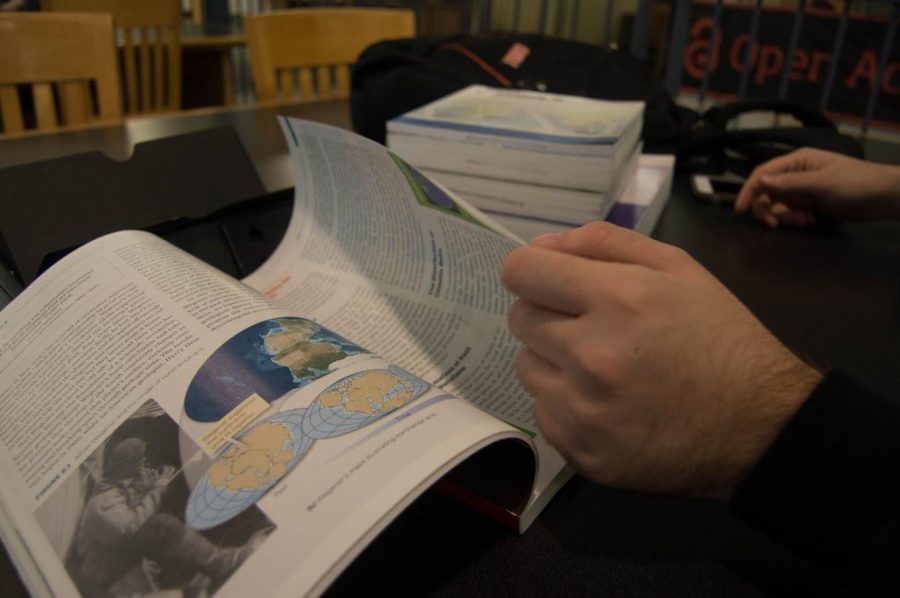One student’s initiative to save money turns into free rentals of course materials
November 14, 2016
Textbook prices are something every student has dealt with. For some the decision to purchase books isn’t easy and, the cost can be more than the amount on the price tag. This is an issue that is currently being addressed atOregon State University.
“Purchasing textbooks have been a major issue for most college students on campus,” said OSU student Enrique Fernandez. “Textbooks are getting so expensive that students end up having to choose whether to pay for rent, buy groceries, or to purchase textbooks for the term. This unfortunate reality is a major issue for students at OSU.”
Fernandez came up with an idea to ease the burden of buying textbooks, by allowing students to borrow them through the Textbook Lending Program.
The program is designed to lessen the cost of higher education by providing textbooks to students in need at no cost. The program is first come first serve and students may check out a book at the Human Services Resource Center and hold it till the Friday of finals week.
The idea came to Fernandez when he realized the importance of textbooks for his success in the classroom.
“One year ago, when taking a math course at Chemeketa Community College I found out that they have a program that allows students to check out books for free for the whole term,” Fernandez said. “I saved $280 because of that program. I immediately asked myself, ‘Why is this program not at Oregon State University?’, and knew that this would have really helped me in that class where I skipped buying the textbook.”
Fernandez has been working with HSRC, the Valley Library, the OSU Foundation, the Women’s Giving Circle and numerous staff members at OSU to get the TLP operational.
Other students have caught wind of Fernandez’s program. The Associated Students Of Oregon State University, the student government, has been striving to help this program branch out to schools across the state and possibly the country. They have been lobbying state legislators and telling the stories of students and how textbook costs affect them.
Rachel Grisham, ASOSU president, believes that this is the start of change in textbook prices.
“It will make a significant difference in students’ lives. It may be in the early stages, but the more people we get excited about this potential the more it will push the momentum for this change, and we could be a state that makes this change across the nation,” Grisham said.
The ASOSU hopes that with more people involved in the conversation they can persuade state legislative to rethink their current position on textbook and education funding. Funding for programs like this is limited, and according to Fernandez, without a grant it would not be possible.
“The HSRC Textbook Lending Program was the result of a grant from the OSU Foundation Women’s Giving Circle and some HSRC working capital matching funds. We’ve only been able to identify the first year’s funding for this program. We’re hoping to create a sustainable funding source in the next year or two,” Fernandez said.
The program launched fall term and is under a trial period but will be available each term this school year.
To apply, students need their OSU ID, a list of enrolled courses, and the list of books needed for the term. The program is open to all students, but pays close attention to students who are in more need than others.
“We have reserved a time for students who have a financial need to have access to the textbooks before the program is open to the whole student body,” Fernandez said. “From the start of the term until the end of week one, students who face financial need and who qualify for priority access can access this program during the appointed time.”
Along with the standard forms, students who are eligible for priority access are required to show documentation of their specified group. Proof can be anything from an ID, an acceptance letter or an account summary of a term. Students can also work with HSRC staff if they are unsure of what documentations qualify, or if they struggle finding documentation.
Textbooks are available for a variety of classes and can be found in similar ways to the books on Valley Reserves, or by asking at the HSRC office. Updates on new textbooks and potential access codes are also posted on their Facebook page and HSRC main website. This is something they hope to simplify, since access codes are one-time-use only.
Since the program is new to OSU there are still some things that the HSRC hopes to work on. Nicole Hindes, coordinator at the HSRC office, knows that this is a team effort.
“There is a survey on the website we will be promoting in the next couple weeks where students can suggest books to buy for the library,” Hindes said. “We can’t promise that we can hold them for people, but it’s a great way for them to tell us what textbooks to invest in.”
While the program is running now, it is only with the help of the community that it will continue to grow, according to Hindes.
“We are still finding a sustainable funding program for the service,” Hindes said. “We hope that students will be generous and donate unwanted textbooks at the end of each term, which will help the program.”
Donations of textbooks or money are welcomed. Information on how to access or help the program can be found at the HSRC website under the textbooks tab.















































































































